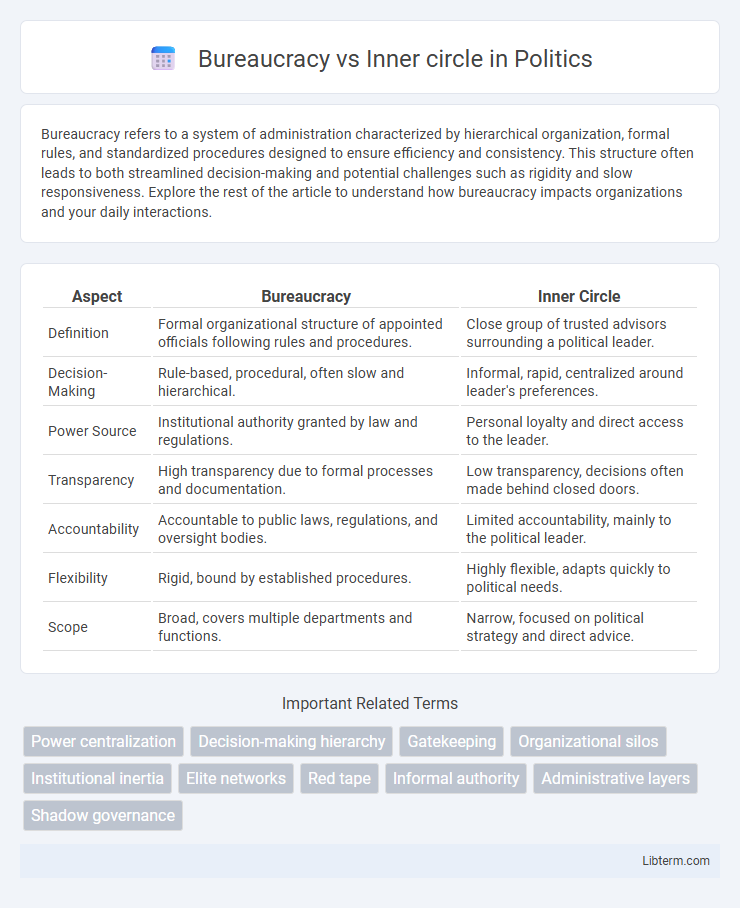Bureaucracy refers to a system of administration characterized by hierarchical organization, formal rules, and standardized procedures designed to ensure efficiency and consistency. This structure often leads to both streamlined decision-making and potential challenges such as rigidity and slow responsiveness. Explore the rest of the article to understand how bureaucracy impacts organizations and your daily interactions.
Table of Comparison
| Aspect | Bureaucracy | Inner Circle |
|---|---|---|
| Definition | Formal organizational structure of appointed officials following rules and procedures. | Close group of trusted advisors surrounding a political leader. |
| Decision-Making | Rule-based, procedural, often slow and hierarchical. | Informal, rapid, centralized around leader's preferences. |
| Power Source | Institutional authority granted by law and regulations. | Personal loyalty and direct access to the leader. |
| Transparency | High transparency due to formal processes and documentation. | Low transparency, decisions often made behind closed doors. |
| Accountability | Accountable to public laws, regulations, and oversight bodies. | Limited accountability, mainly to the political leader. |
| Flexibility | Rigid, bound by established procedures. | Highly flexible, adapts quickly to political needs. |
| Scope | Broad, covers multiple departments and functions. | Narrow, focused on political strategy and direct advice. |
Understanding Bureaucracy: Structure and Function
Bureaucracy operates through a hierarchical structure designed to ensure standardized procedures and efficient management within large organizations or governments. It emphasizes clearly defined roles, formal rules, and a systematic approach to decision-making, contrasting with the inner circle's reliance on informal networks and personal influence. Understanding bureaucracy involves recognizing its function as a mechanism for consistency, accountability, and impartial governance.
Defining the Inner Circle: Power Behind the Scenes
The inner circle represents a core group of influential decision-makers who operate behind the scenes, wielding substantial power beyond formal bureaucratic structures. Unlike the expansive, rule-bound bureaucracy, this inner circle exercises discretionary authority through personal relationships and informal networks. Their ability to shape policies and strategic direction often overrides official protocols, making them pivotal in organizational and political power dynamics.
Origins and Evolution of Bureaucratic Systems
Bureaucracy originated as a structured administrative system designed to manage large organizations and governments efficiently, characterized by hierarchical authority, formal rules, and defined roles. Over time, bureaucratic systems evolved to prioritize standardized procedures and specialization, aiming to reduce arbitrary decision-making inherent in inner circle dynamics, where power is concentrated among a few individuals. The transformation from informal inner circles to formal bureaucracies marked a shift toward institutionalized governance, promoting transparency and accountability in public administration.
Inner Circles: Characteristics and Influence
Inner circles consist of a small, trusted group of advisors or decision-makers who hold significant influence over leadership outcomes and strategic directions. Their characteristics include exclusivity, deep personal loyalty, and consolidated power, often bypassing formal bureaucratic procedures to enable quicker decision-making. The influence of inner circles manifests in shaping policy, controlling information flow, and maintaining organizational stability by reinforcing the leader's authority.
Decision-Making Processes: Bureaucracy vs Inner Circle
Bureaucracy relies on formalized decision-making processes with clearly defined rules, hierarchies, and procedures that ensure consistency and accountability across organizations. In contrast, an inner circle decision-making structure emphasizes informal influence, speed, and flexibility, where decisions are often made by a small group of trusted advisors or key stakeholders. This approach can expedite outcomes but may reduce transparency and limit broader organizational input.
Transparency and Accountability: A Comparative View
Bureaucracy emphasizes transparency through standardized rules and formal procedures that ensure accountability by creating clear lines of responsibility and documentation. In contrast, the inner circle relies on informal networks and discretion, often reducing transparency and making accountability dependent on personal relationships and trust. The bureaucratic system's structured approach promotes consistent oversight, whereas the inner circle's opacity can lead to centralized power and potential challenges in governance.
Efficiency and Adaptability: Strengths and Weaknesses
Bureaucracy offers efficiency through standardized procedures and clear hierarchies, ensuring consistent outcomes but often at the cost of adaptability due to rigid structures. Inner circles excel in adaptability by enabling rapid decision-making and flexibility, yet they risk inefficiency via limited oversight and potential favoritism. Balancing bureaucratic stability with inner circle agility is essential for organizations seeking both reliable performance and swift responsiveness to change.
Case Studies: Bureaucracy and Inner Circle in Action
Case studies of bureaucracy reveal rigid hierarchical structures that prioritize rules and standardized procedures, often leading to slower decision-making and reduced flexibility in organizations. In contrast, inner circle models showcase small, close-knit groups of top executives who facilitate rapid decision-making through trust and direct communication, as demonstrated by companies like Apple under Steve Jobs. The contrasting outcomes highlight how bureaucracy ensures compliance and consistency, while inner circles drive innovation and agility.
Impact on Organizational Culture and Morale
Bureaucracy often fosters rigid hierarchies and standardized procedures, which can lead to decreased morale and stifled innovation within organizational culture. In contrast, an inner circle promotes centralized decision-making and trust-based relationships, enhancing agility but potentially causing exclusivity and favoritism that undermine broader team cohesion. Balancing structured processes with inclusive leadership is crucial to sustaining a positive organizational culture and high employee morale.
Navigating Power Dynamics: Finding a Balanced Approach
Navigating power dynamics requires understanding the distinctions between bureaucracy and the inner circle, where bureaucracy emphasizes formal procedures and hierarchical decision-making while the inner circle relies on informal influence and close relationships. A balanced approach integrates structured processes with strategic networking to ensure transparency and agility in leadership. This synergy enhances organizational effectiveness by fostering accountability alongside adaptive, relationship-driven influence.
Bureaucracy Infographic

 libterm.com
libterm.com